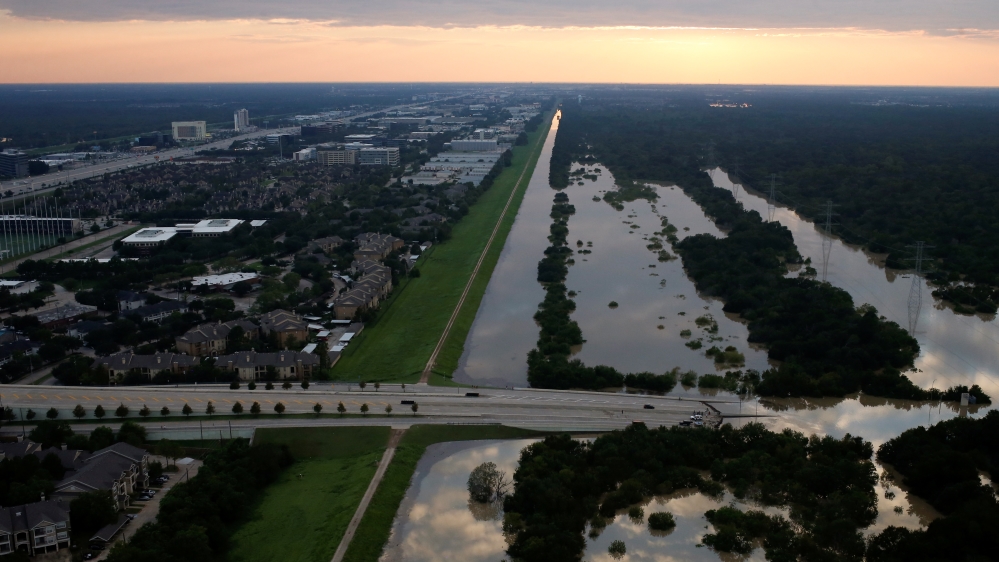Blasts rock Texas chemical plant as Harvey weakens
Threat from tropical depression Harvey moves to near Texas-Louisiana line as death toll rises to at least 31.

Two explosions were reported at a flooded chemical plant in the US state of Texas on Thursday, as the remnants of tropical storm Harvey moved further east near the Texas-Louisiana line.
Harvey, which was downgraded to a tropical depression late on Wednesday, killed at least 31 people and drove tens of thousands from their homes since it first slammed onshore as a Category Four hurricane on Friday night.
Keep reading
list of 4 itemsAfter the Hurricane
World’s coral reefs face global bleaching crisis
Why is Germany maintaining economic ties with China?
|
|
The death toll was rising as bodies were found in receding waters.
Early on Thursday, the Arkema plant in Crosby, which lost power after Harvey engulfed the area in extensive floods, was rocked by two explosions due to lack of refrigeration, according to its operator.
Fire authorities said that the blasts were small and that some deputies suffered irritated eyes from the smoke, but they emphasised that the materials that caught fire shortly after midnight were not toxic.
In the largely rural area surrounding the plant, officials said they had gone door-to-door to explain the situation and call on residents to evacuate, but leaving was not mandatory.
IN PICTURES: Harvey causes havoc in Texas
The plant was shut down before Harvey made landfall last week, but a crew of 11 had stayed behind. That group was removed and residents living within a 2.4-km radius were told to evacuate on Tuesday after the plant lost power.
Floodwaters also toppled two oil storage tanks in South Texas, spilling more than 110,000 litres of crude.

Fort Bend County in Texas ordered a mandatory evacuation on Thursday for areas near the Barker Reservoir, which was threatening to flood. The reservoir is about 32km west of Houston.
The county did not say how many people the evacuation order would affect.
|
|
Beaumont and Port Arthur cities of Texas worked to evacuate residents after Harvey completed a U-turn in the Gulf of Mexico and rolled ashore early on Wednesday for the second time in six days.
It hit southwestern Louisiana as a tropical storm with heavy rain and winds of 72kph.
In Houston, where Mayor Sylvester Turner issued a night-time curfew to aid search efforts and thwart potential looting, the two major airports had reopened on a limited basis, signalling a slow return to normality.
Houston’s two major airports were up and running again on Wednesday.
Officials said they were resuming limited bus and light rail service as well as rubbish pick-up.
READ MORE: Flooding kills family of six as Harvey hits Louisiana
At the same time, many thousands of Houston-area homes are under water and could stay that way for days or weeks.
Officials said 911 centres in the Houston area are getting more than 1,000 calls an hour from people seeking help.
Heavy downpours were expected to stop on Thursday, though “life-threatening” flooding was to continue in southeastern Texas and southwestern Louisiana.
Counting damages
Harvey’s five straight days of rain totalled about 130cm, the heaviest tropical downpour ever recorded in the continental United States.
Altogether, more than 1,000 homes in Texas were destroyed and close to 50,000 damaged, and more than 32,000 people were in shelters across the state, emergency officials reported.
About 10,000 more National Guard troops are being deployed to Texas, bringing the total to 24,000, Governor Greg Abbott said.
Enki Research put its “best estimate” of Texas storm damage at between $48bn and $75bn.
![More than 1,000 homes in Texas were destroyed and close to 50,000 damaged [Win McNamee/Getty Images/AFP]](/wp-content/uploads/2017/08/9017003f46234d7ab63dbde00d6e7c76_18.jpeg)